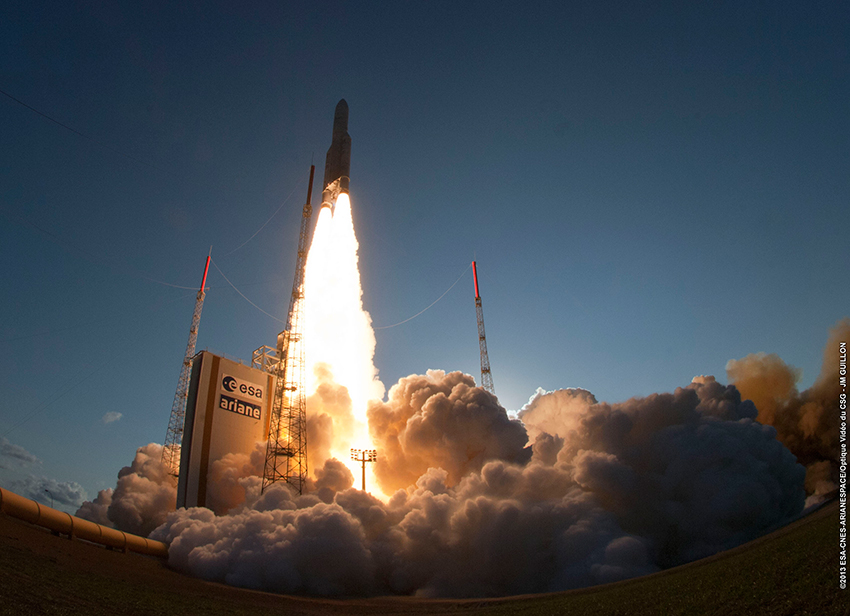
While 2015 saw the space community celebrate the 25th anniversary of the world’s premier space telescope (the Hubble Space Telescope, or HST), another space telescope hit major development milestones on terra firma – the James Webb Space Telescope (JWST), a NASA, Canadian Space Agency (CSA), and European Space Agency (ESA) collaboration. On Thursday, Dec. 17, another step toward launch was ticked off as ESA announced it had signed a contract with Arianespace, aiming the next great space observatory for an October 2018 launch aboard an Ariane 5 launch vehicle from Europe’s Spaceport in Kourou, French Guiana. In addition, further testing on the vital scientific “brain” of the telescope continues, while its flight mirrors continue to be installed.
Vehicle Specifics, Launch Window Revealed
The JWST has been billed as the most powerful space telescope ever built. A real “time machine” that will function primarily in infrared, it will have the capability to peer 13.5 billion years back into time to see the births of galaxies and stars. But before JWST looks back into our Universe, it must be launched aboard one of Europe’s flagship launch vehicles – and it must be a good fit.
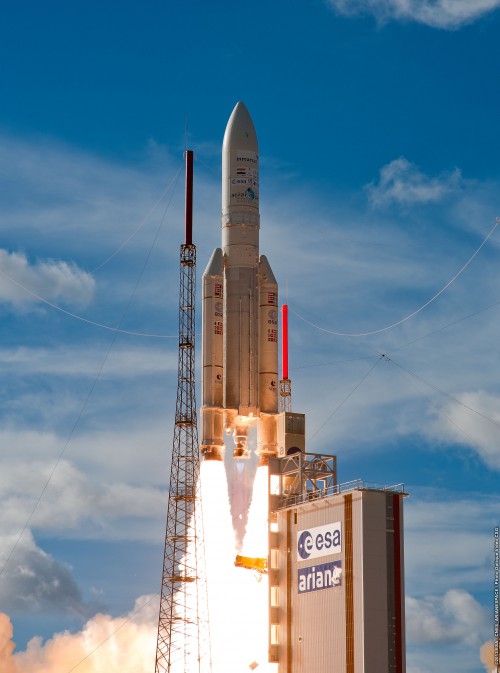
ESA underscored how the telescope, which has a 6.5 meter (21.3 foot) segmented primary mirror, must be “folded” into the Ariane 5’s fairing; the space agency stated, “The contract includes a cleaner fairing and integration facility to avoid contaminating the sensitive telescope optics.” Peter Jensen, ESA’s JWST project manager, stated to AmericaSpace, “We do not need any modification to the the standard AR5 ECA rocket, fairing and launch service ground facilities. We will, however, exercise stricter than normal cleanliness control measures for the facilities and the fairing during the launch campaign.” Jensen added, “The launch window in October is around midday (UTC), [which is] early morning in Kourou.”
As outlined previously by AmericaSpace Senior Writer Ben Evans, “Standing 171 feet tall and weighing almost 1.7 million pounds, the two-stage Ariane 5 represents one of the most powerful launch vehicles in operational service. Since its ill-fated first flight in June 1996, it has supported over 75 missions, of which only four have been classified as total or partial failures. On its very first launch, it succumbed to a control software glitch, which caused it to veer from its intended flight path and the flight termination system destroyed the vehicle. The second mission, in October 1997, fared little better, but suffered a premature shutdown of its core stage and failed to attain orbit. Two others, in July 2001 and December 2002, also underperformed, but Ariane 5 has maintained an unblemished record ever since.”
NASA’s Eric Smith, the U.S. space agency’s JWST program director, emphasized the importance of JWST’s latest milepost. “The years of hard work and excellent collaboration between the NASA, ESA and Arianespace teams that have made this possible are testimony to their dedication to the world’s next great space telescope,” Smith related. ESA’s Director General, Jan Woerner, seconded Smith’s sentiment by adding, “With this key contract now in place with our long-standing partners, we are closer than ever to seeing the scientific goals of this next-generation space observatory realized.”
ISIM Continues To Undergo Testing While Mirrors Are Installed
While JWST moves closer to its Ariane 5 launch less than three years out, the telescope itself continues to come together as its final assembly is underway. Its Integrated Science Instrument Module (ISIM), which contains JWST’s four flight instruments, has entered final pre-delivery environmental testing; according to NASA, the ISIM is in its “full final” state prior to launch.
A previous AmericaSpace article reported, “In June, the ISIM completed the first round of the final tests, which included vibration tests of the ‘ISIM prime’ module. The ISIM will soon undergo Electromagnetic Interference/Electromagnetic Compatibility (EMI/EMC) tests, and an extensive cryo-vacuum test to duplicate the conditions the component will experience in space. These tests are scheduled to be complete in early 2016; after completion, the ISIM will be delivered to NASA’s Goddard Space Flight Center to be integrated with JWST’s Optical Telescope Element.”
In November, NASA announced that the first of 18 flight mirrors had been installed at the agency’s Goddard Space Flight Center in Greenbelt, Md. As of Thursday, Dec. 17, six of the 18 mirrors had been successfully installed, with number seven perched on a robotic arm ready for installation. The arm is being used to precisely “lift and lower” the 4.2 foot-wide, 88 pound segments precisely into place.
The telescope will utilize 18 mirrors, as one large mirror would be too heavy and unwieldy for the Ariane 5 launch vehicle. A previous AmericaSpace article addressed the unique design of the mirror assembly: “Each mirror segment will unfold and adjust its shape after launch, and are composed of ultra-lightweight beryllium which is known for its thermal and mechanical properties at cryogenic temperatures. Each segment can also reflect ultraviolet light using a thin coating of gold.” The full installation of the mirror segments is scheduled to be completed in early 2016.
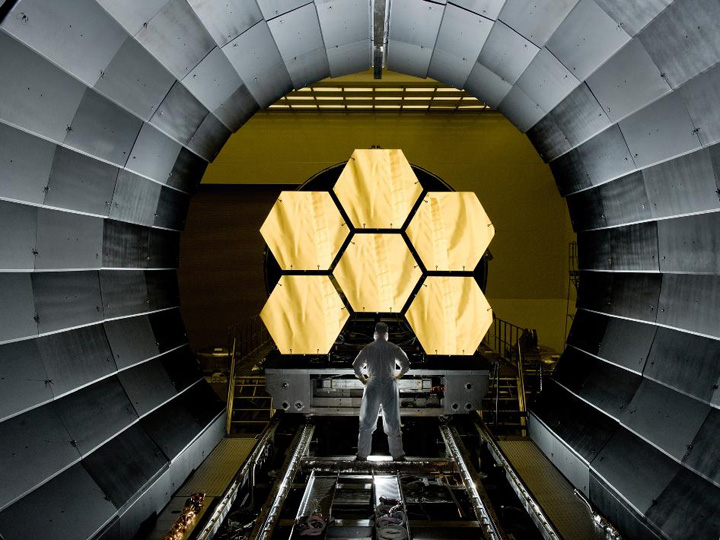
Just a few days ago the telescope’s Aft Optics Subsystem, or AOS, was delivered to Goddard from Johnson Space Center. According to NASA, “The AOS is at the center of JWST’s primary mirror; light is sent there by the secondary mirror. In the AOS is JWST’s tertiary mirror. From there light is sent via pick-off mirror to our instruments.
Here’s an animation that shows the path light takes to get to JWST’s instruments (including how light travels in the AOS).
The telescope will also employ an innovative tennis court-sized sunshield, as the telescope will be exposed to extreme temperature differences where it operates – the second Lagrangian point, or L2, which is one million miles away from the Earth. HST, in contrast, operates in low Earth orbit, and was able to be serviced by shuttle astronauts during five servicing missions.
*****
With the Ariane 5 contract in place and mirror installation well on its way to completion, the world’s next great observatory wraps up 2015 on course to the stars. ESA’s Jensen stated, “With the launch service agreement formally agreed, and with NASA’s continuing solid progress of integrating and testing JWST, we keep the steady pace towards the launch in October 2018.”
Be sure to “Like” AmericaSpace on Facebook and follow us on Twitter: @AmericaSpace
.
Missions » James Webb Telescope »



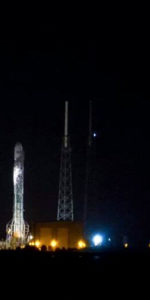
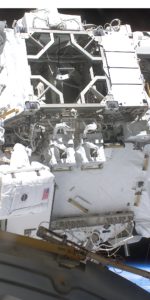
Why specify a morning launch time but not a specific date? I assume this has something to do with reaching L2?